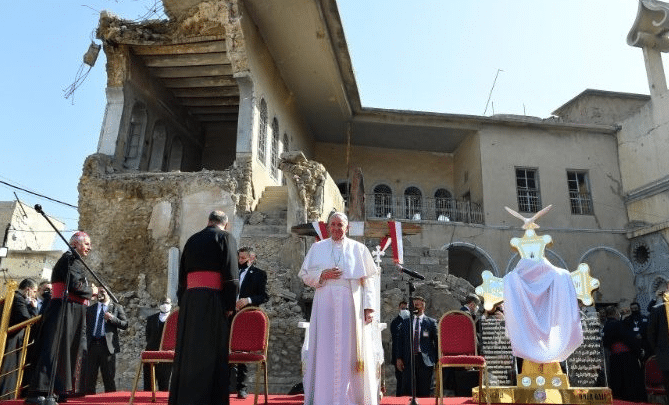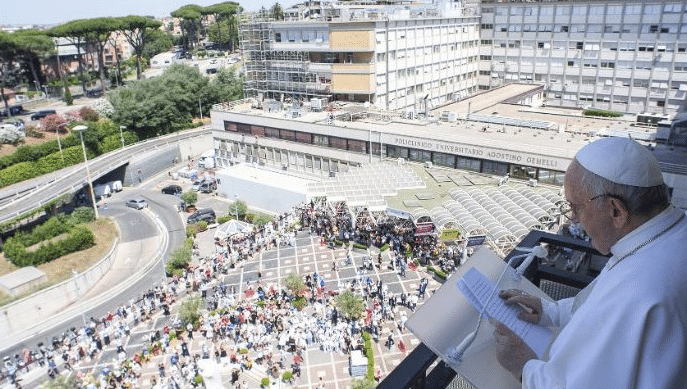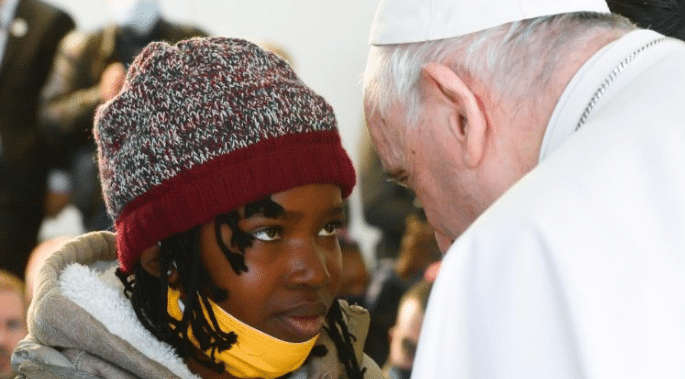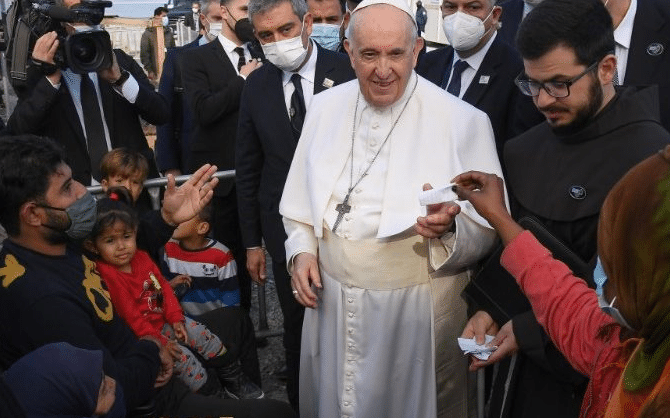Three international Apostolic Journeys, from war-ravaged Iraq to the peripheries of Slovakia and the suffering of refugees in Lesbos. Eight Motu Proprios, on issues as diverse as ministries for women, changes to the Vatican judicial system, and the regulation of the older form of the Mass. The start of an unprecedented synodal path that will involve all the dioceses throughout the world. Encounters and audiences, as well as international events inside and outside Rome. And, in the midst of a busy year, the Pope underwent an operation on his colon at Rome’s Gemelli Hospital.
The past year with Pope Francis deserves to be reviewed in its entirety, considering the mass of appointments and commitments that have seen the Pope as protagonist – a fact that should not be taken for granted in a year filled with uncertainties and restrictions caused by the Covid emergency; and taking into account the health conditions of the 85-year-old Pontiff, who began the year with sciatica problems that prevented him from presiding over the Te Deum on 31 December and the Mass on 1 January
A vaccine for the body, a vaccine for the heart
The year that is now drawing to a close opened with the Pope still “caged” (borrowing his own expression) in the Apostolic Library for the Sunday Angelus and General Audiences, in order to avoid crowds and contagion. From the Vatican Apostolic Palace, streamed live worldwide, as the world faced 2021 bearing the wounds of the pandemic, Pope Francis began the year with these words:
“While we hope for new beginnings and new cures, let us not neglect care. Together with a vaccine for our bodies, we need a vaccine for our hearts. That vaccine is care. This will be a good year if we take care of others…”
Pilgrimage to Iraq

The Argentine Pope’s “cure” took the form of three international trips to different parts of the world wounded by war, poverty, and migration. First and foremost – and not just chronologically – was the 5-8 March visit to Iraq: the trip of the pontificate, the first by a Pope in the Middle Eastern region devastated by extremist violence and jihadist profanations. The decision, announced in December 2020, was seen by many as hazardous and risky, due not only to the danger of contagion but also for security reasons. The Pope, however, wanted to go through with visit, so as not to disappoint the people who, twenty years earlier, had been unable to embrace John Paul II.
Among the suffering people who welcomed him in the dusty neighbourhoods of Baghdad or the dirt roads of Qaraqosh, Pope Francis made himself present as a “pilgrim,” also meeting Ayatollah Ali al-Sistani, a pivotal figure in Shiite Islam. And from Mosul, the scene of torture and executions in the past, he raised a cry to the heavens against all forms of violence carried out in the name of God.
Among the poor in Slovakia and migrants in Lesbos
This cry came to the fore once again during his trip to Slovakia (12-15 September): from the Shoah memorial in Bratislava, Pope Francis spoke of “blasphemy” when the name of God is used to destroy human dignity; and in the Roma ghetto of Luník IX, he stigmatised racism and discrimination.
His cry became an appeal and then a condemnation of that “shipwreck of civilisation” that takes the form of barbed wires and migrant shacks – sweltering in summer and freezing in winter – where thousands of migrants live in inhuman conditions in the Reception and Identification Centre of Lesbos, which the Pope visited at the end of the trip to Cyprus and Greece (2-6 December).
From this limbo at the gates of Europe, after having “looked into the eyes” of the wounded flesh of men, women, and children, Pope Francis’ voice resounded forcefully:
“Let us not allow our sea (mare nostrum) be transformed into a desolate sea of death (mare mortuum).”
Reforms
While travelling around the world, but with his eyes fixed on the reforms that will take shape in the next apostolic constitution Praedicate Evangelium, Pope Francis published eight Motu proprios from January to November, which introduced changes and innovations in the pastoral, financial, and judicial spheres.
The first, Spiritus Domini (11 January), established that the lay ministries of Lector and Acolyte may be entrusted to women. Then came the Motu proprio of 16 February which updated the Vatican’s criminal justice code, followed by the Apostolic Constitution Pascite gregem Dei, signed on 23 May, promulgating the new Book VI of the Code of Canon Law which contains regulations on canonical criminal sanctions in the Church. On 24 March, considering the deficit that had characterised the Holy See’s economic management for years and the worsening circumstances caused by the pandemic, the Pope decided to cut the salaries of cardinals, superiors and religious. In the same vein, on 29 April, he introduced an anti-corruption clampdown, stipulating that senior managers would have to sign a declaration stating that they had no criminal convictions and were not under investigation for terrorism, money laundering, or tax evasion; and stipulating that they could not have assets in tax havens. The following day, 30 April, the decision was made that the Vatican tribunal would also be competent for criminal trials involving cardinals and bishops. On 11 May, Pope Francis published Antiquum ministerium, establishing the ministry of catechist. In the middle of summer, on 16 July, he promulgated Traditionis custodes, which redefined the procedures regulating the use of the older form of the Roman Missal. The document received generally positive reactions, but also provoked several dubia that were answered by the Congregation for Divine Worship on 18 December. The final Motu proprio was issued on 26 November to set up a Pontifical Commission to verify and apply Mitis Iudex Dominus Iesus (in force for six years) on matrimonial nullity processes in the Italian Church.
An unprecedented test case: the London real estate trial
On the subject of trials, 2021 was also the year of the two significant legal proceedings at the Vatican Tribunal: one for alleged sexual abuse in the Saint Pius X Preseminary, which began on 14 October 2020 and ended on 6 October 2021 with the acquittal of the two defendants; and the ongoing trial for alleged financial wrongdoing concerning funds from the Secretariat of State. Begun on 27 July, the trial, now in its fifth hearing and still stuck in procedural skirmishes, will resume on 25 January.
Surgical operation at Gemelli

En la historia del pontificado, el año que está a punto de terminar será recordado también por las noticias sobre la salud del Papa. Empezando por la citada ciática, luego la vacuna de Pfizer a la que se sometió el Pontífice el 13 de enero (con posteriores refuerzos) y, finalmente, su ingreso en el Gemelli el 4 de julio para una operación “programada” de estenosis diverticular que le hizo permanecer diez días en el “Vaticano III” (Policlínico Gemelli) y de la que parece haberse recuperado bastante rápido.
In the history of the pontificate, the year that is about to end will also be remembered for the news about the Pope’s health. Starting with sciatica, then the Pfizer vaccine which the Pontiff received on 13 January (with subsequent booster shots), and finally the admission to Gemelli, on 4 July, for a pre-planned operation for diverticular stenosis which saw him stay for ten days in the so-called “third Vatican.”
From the tenth floor of the Roman hospital, the Pope appeared for the Angelus recitation, with some children from the oncology ward beside him, calling for good health care to be “accessible” to all. The operation offered the occasion for speculation about the possibility of the Holy Father resigning. He himself spoke to the issue in a long interview with the Spanish radio station COPE, stating that such a decision had never crossed his mind.
An unprecedented synodal path
The year 2021 was also the year in which Pope Francis introduced one of the most important novelties from an ecclesial point of view: the opening of a three-year-long synodal path, which will commence “from below,” that is, from the faithful – but also from every part of the world, and which will culminate in 2023 with a great assembly in the Vatican. The three phases of this new itinerary were announced in May: the synodal path opened with a Mass in St Peter’s on 10 October, and will be followed by diocesan, continental, and universal phases.
The Synod should not become “a Church convention, a study group or a political gathering, a parliament, but rather a grace-filled event, a process of healing guided by the Spirit.”
Vaccines, the climate, peace, the poor

Numerous appeals have marked these twelve months, begin with those in favour of Covid vaccines. On the one hand, the Pope called for equitable distribution and rapid access to the vaccines, especially in the poorest areas of the world.
“May everyone, without exclusion, be given the opportunity to be protected by the vaccine as soon as possible”, said the Pope as he presided over a Rosary for the end of the pandemic in the Vatican Gardens on 31 May. Pope Francis also encouraged people not to give in to scepticism, fake news, and ideologies; and to receive vaccination, because doing so “is an act of love” – a position reinforced by the Holy See, which on 22 December introduced new provisions for entry into Vatican City.
The Pope also made appeals for the earth and the safeguarding of our common home – a plea eloquently expressed in Laudato sí and renewed in Fratelli tutti. On the very day of the latter encyclical’s first anniversary, Pope Francis gathered scientists and leaders of different religions at the Vatican for an encounter ahead of the COP26 Meeting in Glasgow (which he was unable to attend). The Vatican gathering concluded with the signing of a joint document calling for zero net carbon emissions. Two months earlier, on 7 September, with the Patriarch of Constantinople, Bartholomew, and the Archbishop of Canterbury, Justin Welby, the Pope had signed an appeal on the urgency of environmental sustainability and the importance of global cooperation.
With equal vigour, Pope Francis has kept the focus on issues of peace and disarmament. One cannot forget the words he spoke on 7 October at the Colosseum for the meeting, organised by the Sant’Egidio Community, with representatives of the various religions. The Bishop of Rome made an appeal to “demilitarise hearts… lay down arms… reduce military spending… [and] convert instruments of death into instruments of life,” investing in education and health.
Without forgetting the poor

Among the many meetings – despite the pandemic – with Heads of State and Government (including US President Joe Biden, French President Emmanuel Macron, the President of the European Commission, Ursula von der Leyen, and the last one with outgoing Italian President Sergio Mattarella), political leaders or civil society, Francis did not forget the poor: those for whom he chose the name of the Poverello of Assisi at the Conclave that elected him in 2013.
It was in the hometown of the Umbrian saint, on 12 November, that the Pontiff brought together more than 500 people living in poverty and hardship from Italy and Europe. The private visit was his only journey within Italy this year. Amidst moving testimonies, songs and prayers in the Basilica of Santa Maria degli Angeli, the Pope pointed out the new forms of poverty, such as women treated as bargaining chips; children enslaved, starving, shipwrecked; families suffering social inequalities; and the unemployed; and called for the poor to be “given back” their voice and dignity. He called for the cancellation of the debt of poor countries, a ban on arms, an end to aggression and sanctions, and the liberalisation of patents so that everyone has access to vaccines. Pope Francis also relaunched two proposals to be implemented immediately: a minimum wage and a reduction in the working day.
Looking ahead to 2022
Two important events are planned for the new year: on 27 February, the meeting organised by the Italian Bishops’ Conference in Florence with the bishops and one hundred mayors of the countries bordering the Mediterranean; and on 22-26 June, the tenth World Meeting of Families in Rome on the theme “Family love: A vocation and path to holiness.”
As far as international trips are concerned, a visit to Canada has been announced (dates are not yet official), in the context of the reconciliation process between the episcopate and indigenous peoples, disrupted by the discovery of mass graves at the former residential schools that had been entrusted by the government, to various Christian Churches, including the Catholic Church.
In various interviews, Pope Francis has also expressed a desire to visit Congo, Papua New Guinea, East Timor, and Hungary in the future – the latter would be a quick stop in September for the conclusion of the International Eucharistic Congress in Budapest.
The desire for a pilgrimage to Lebanon, in the grip of a serious humanitarian, political and economic crisis, a country for which he prayed with the heads of the Eastern Churches on a day of ecumenical prayer on 1 July in St Peter’s, has never faded. Nor has the desire to visit South Sudan with the Anglican Archbishop of Canterbury Justin Welby. Recently, the Secretary for Relations with States, Archbishop Paul Richard Gallagher, went to prepare the way for the Pope’s arrival “probably already next year.”
Finally, on the return flight from Athens, the Pope said he was “always willing to go to Moscow” to meet again, after the 2016 meeting in Cuba, with Kirill, the Orthodox Patriarch of Moscow and All Russia.



